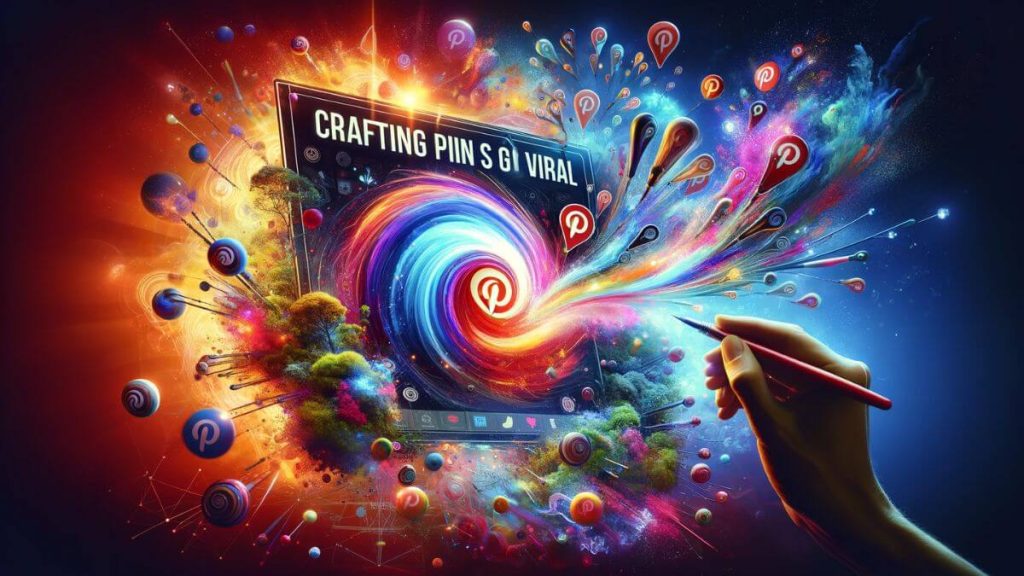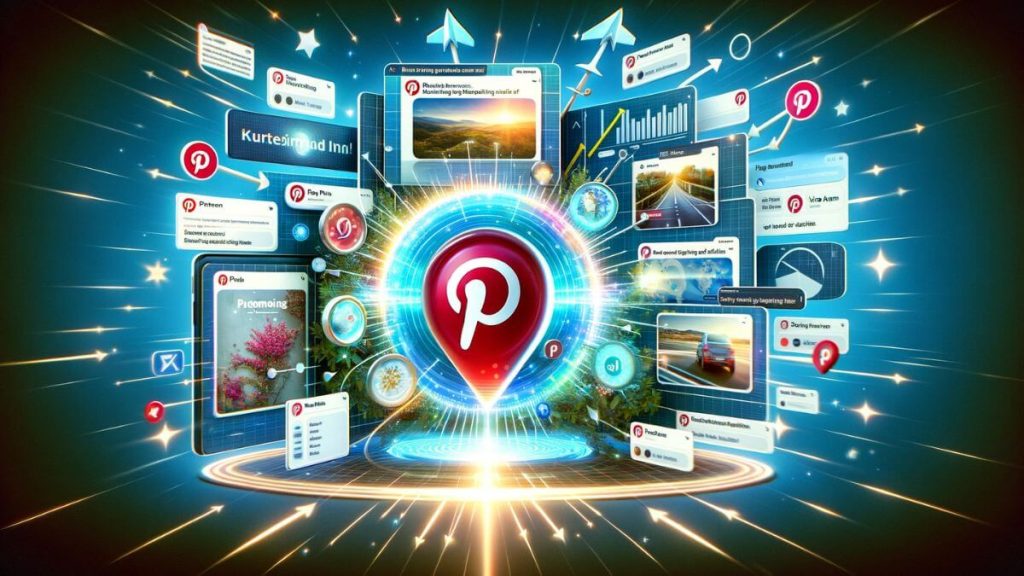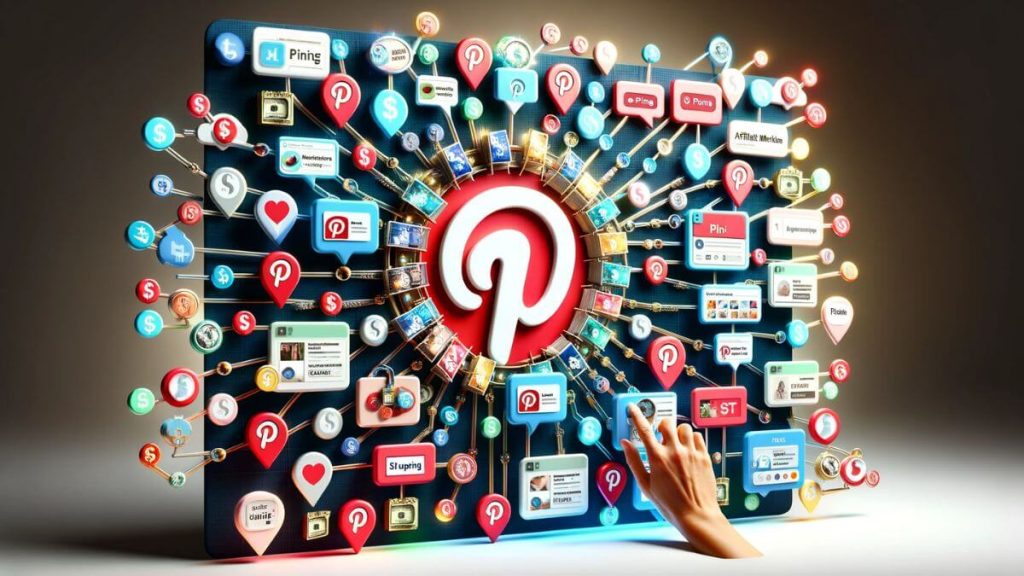Blogging Pinterest Strategy
Welcome to my new guide about blogging Pinterest strategy!
In this blog, I shared with you all you need to know about the basics of blogging and also about the love of blogging. Now it’s time to give you a comprehensive guide to Pinterest strategy.
In this guide, you are going to learn many things related to using Pinterest as a source of traffic to your blog, but also how to make money on Pinterest, and much more…
- But why do I share this with you?
- Why does Pinterest’s strategy for bloggers like yourself matter?
Pinterest strategy for bloggers involves creating high-quality, visually appealing pins, consistently pinning, utilizing SEO with relevant keywords in descriptions, engaging with others’ content, and tracking analytics to refine tactics and increase blog traffic.
- Pinterest Strategy for Bloggers
- How to Use Pinterest for Blogging
- Optimizing Pinterest Profiles
- Pinterest SEO Tactics
- Rich Pins Utilization
- Increasing Pinterest Traffic
- Creating Effective Pins
- Understanding Pinterest Analytics
- Strategic Pinterest Boards
- Integrating Blog Content
- Using Tailwind for Pinterest
- Crafting Viral Pins
- Running Pinterest Ads
- Seasonal Pinning Techniques
- Leveraging Group Boards
- Pinterest Affiliate Marketing
- Conclusion on Blogging Pinterest Strategy
Pinterest Strategy for Bloggers
To get you started with my blogging Pinterest strategy guide, I list below an easy-to-follow list of main topics, that further expand into more in-depth articles…
- How to Use Pinterest for Blogging
- Optimizing Pinterest Profiles
- Pinterest SEO Tactics
- Rich Pins Utilization
- Increasing Pinterest Traffic
- Creating Effective Pins
- Understanding Pinterest Analytics
- Strategic Pinterest Boards
- Integrating Blog Content
- Using Tailwind for Pinterest
- Crafting Viral Pins
- Running Pinterest Ads
- Seasonal Pinning Techniques
- Leveraging Group Boards
- Pinterest Affiliate Marketing

How to Use Pinterest for Blogging
The first question that comes to one’s mind when talking about Pinterest strategy for bloggers is how to use this platform.
Pinterest has become an invaluable platform for bloggers looking to expand their reach and drive traffic to their websites. Understanding how to effectively use Pinterest for blogging can greatly enhance your online presence and help you achieve your blogging goals.
From seasonal content planning to utilizing rich pins effectively, there are various strategies that can be employed to maximize the potential of Pinterest as a blogging tool. One of the first steps in utilizing Pinterest for blogging is to enhance your Pinterest profile.
Your profile acts as a virtual representation of your blog, so it’s important to make sure it accurately reflects your brand and attracts potential readers. Start by choosing a clear and captivating profile picture that aligns with your blog’s theme or logo.
Craft a compelling bio that includes relevant keywords related to your niche or topics you frequently cover in your blog posts. This will improve the chances of appearing in Pinterest search results when users are looking for content similar to what you provide.
Next, it’s crucial to create boards on Pinterest that are tailored specifically towards your blog’s content. Organizing Pinterest boards allows users who visit your profile to easily navigate through different categories and find the specific type of content they’re interested in reading.
For instance, if you have a fashion blog, you could create boards centered around different fashion trends, outfit inspiration, or styling tips. By doing this, you not only make it easier for users to discover relevant content but also establish yourself as an expert in your niche.
In addition to organizing boards, collaborating with other bloggers through group boards can be an effective way to grow your audience on Pinterest. Group boards allow multiple contributors to share their content on one board, expanding exposure and reaching new audiences that may not have discovered your blog otherwise.
Seek out group boards within your niche or related topics and request collaboration with their owners or administrators. Ultimately, using Pinterest for blogging requires a comprehensive strategy that encompasses various elements such as SEO optimization, pin design excellence, and strategic board organization.
By implementing these strategies, bloggers can leverage the power of Pinterest to drive traffic, increase engagement, and ultimately monetize their blogs. So dive into the world of Pinterest blogging with a well-defined plan and watch as your blog gains traction and your audience grows.

Optimizing Pinterest Profiles
The second thing that comes to when talking about Pinterest strategy for bloggers is how to optimize your Pinterest profile.
Let’s get into it!
When it comes to leveraging the power of blogging Pinterest strategy, optimizing your Pinterest profile is a crucial step in establishing a strong online presence and attracting a larger audience. To enhance your Pinterest profile, start by ensuring that you have a visually appealing and professional profile picture that accurately represents your brand or blogging niche.
Use high-quality images that align with your overall branding strategy to create an instant connection with potential followers. Next, focus on crafting a compelling bio that clearly communicates who you are as a blogger and what value you bring to the table.
Keep it concise yet informative, highlighting your expertise and unique selling points. Incorporate relevant keywords into your bio to improve its visibility in Pinterest search results, thus enhancing your chances of being discovered by users interested in topics related to your blog.
Another key element in optimizing your Pinterest profile is curating eye-catching and organized boards. Create boards that align with the topics relevant to your blog, making it easier for users to find content that resonates with their interests.
Be strategic in naming each board – use descriptive titles incorporating keywords whenever possible to boost their visibility on the platform. In addition to creating original boards, consider joining collaborative boards within your blogging niche or working with other bloggers on group boards.
This not only helps you expand the reach of your pins but also enables you to tap into new audiences who share similar interests. Take advantage of rich pins – special pins that provide additional information directly on the pin itself – effectively by enabling them for your website or blog content.
Rich pins enhance user experience and improve engagement by displaying details such as article headlines or product prices directly on the pin itself. By utilizing rich pins effectively, you can make it easier for users to access information from within Pinterest without having to leave the platform.
By following these optimization strategies for your Pinterest profile, you can significantly increase brand visibility, grow your Pinterest audience, and ultimately drive more traffic toward your blog. Remember that a well-optimized Pinterest profile serves as a gateway to your blog, attracting potential readers who share your passion for the love of blogging.

Pinterest SEO Tactics
When it comes to Pinterest, one cannot underestimate the power of search engine optimization (SEO) in driving traffic to your blog. Utilizing effective SEO strategies on Pinterest can significantly boost your visibility and increase the chances of your pins being discovered by a wider audience.
Here are some key tactics to optimize your presence on Pinterest: 1. Strategic Keyword Research: Just like with any other search engine, using relevant keywords is crucial for improving your ranking on Pinterest.
Conduct thorough keyword research using tools like Google Keyword Planner or Pinterest Trends to identify popular keywords in your niche. Incorporate these keywords strategically into your pin descriptions, board titles, and board descriptions to improve their visibility in search results.
2. Optimized Pin Descriptions: Crafting compelling and keyword-rich pin descriptions is vital for both user engagement and searchability. Aim for concise yet descriptive descriptions that not only entice users to click but also contain relevant keywords related to the content of your blog post.
Be sure to include a call-to-action encouraging users to visit your blog or take a desired action.
3. Utilize Rich Pins Effectively: Rich pins provide enhanced information directly on the pin itself, making them more informative and visually appealing.
There are several types of rich pins available such as article pins, recipe pins, product pins, and more. By enabling rich pins for your blog’s content, you can provide additional details like article titles, author names, product prices, etc., which not only make your pins stand out but also contribute towards better SEO rankings.
4. Optimize Board Titles and Descriptions: When organizing your Pinterest boards, be mindful of using targeted keywords in both board titles and descriptions. This will help categorize your content effectively while aiding search engines in understanding what each board is about.
Additionally, consider creating themed boards around specific topics or seasonal content planning as this can attract followers who have an interest in those specific areas. By implementing these SEO tactics, you can enhance your Pinterest profile, increase your visibility on the platform, and ultimately drive more traffic to your blog.
Remember that consistency is key – regularly updating and optimizing your Pinterest boards and pins will yield the best results. So, embrace the love of blogging on Pinterest and watch as your audience grows!

Rich Pins Utilization
One of the key strategies for bloggers on Pinterest is to effectively utilize rich pins.
Rich pins are a powerful tool that allows you to provide more detailed information about your blog content directly on Pinterest. There are four types of rich pins available: article, product, recipe, and app.
By enabling rich pins on your website and optimizing them for Pinterest, you can enhance both the visibility and engagement of your content. To use rich pins effectively, start by ensuring that your website is properly set up with the required meta tags.
These tags provide Pinterest with the necessary information to display your content as a rich pin. Once you have implemented these tags, validate them using Pinterest’s Rich Pins Validator tool to ensure they are working correctly.
When it comes to article-rich pins specifically, make sure that you include captivating titles and descriptions that entice users to click through to your blog post. This can help increase traffic and ultimately improve your blog’s performance metrics.
Additionally, consider adding relevant keywords in the title and description for better discoverability through Pinterest’s search functionality. Another way to leverage rich pins is by utilizing them for product-related content.
If you have an online shop or sell products related to your blog niche, enabling product-rich pins can be an effective way to drive potential customers directly from Pinterest to your website. In addition, optimize product-rich pins by including compelling images and detailed descriptions that highlight the unique features or benefits of each product.
By taking advantage of rich pins on Pinterest, bloggers can significantly enhance their profile presence and increase their audience reach. Incorporate these strategies into your Pinterest strategy along with other tactics such as tailwind Pinterest scheduling, compelling pin designs, and organizing boards strategically around specific topics or themes like seasonal content planning or collaboration boards with other bloggers in your niche.
Remember that it’s not just about traffic generation but also monetizing Pinterest pins effectively by converting them into actual customers or subscribers once they land on your blog. With the right approach, Pinterest can become a valuable source of targeted traffic and an essential part of your overall blogging strategy.

Increasing Pinterest Traffic
One of the key goals for bloggers on Pinterest is to increase their website traffic through the platform. This is a very important aspect of the Pinterest strategy for bloggers.
Fortunately, there are several effective strategies that can help achieve this objective. First and foremost, bloggers should consider utilizing Tailwind, a popular Pinterest scheduling tool.
By strategically planning and scheduling pins at optimal times when their target audience is most active, bloggers can ensure maximum visibility for their content. In addition to scheduling pins, bloggers can also explore the option of using Pinterest-promoted pins.
These are paid advertisements that appear in users’ feeds and search results, providing an excellent opportunity to reach a wider audience. By carefully selecting relevant keywords and targeting specific demographics, bloggers can effectively promote their content and drive more traffic to their blogs.
Another important aspect to consider when aiming to increase Pinterest traffic is implementing effective Pinterest SEO strategies. This involves optimizing pin descriptions, titles, and board names with relevant keywords related to the blog’s niche.
By doing so, bloggers improve the chances of their content appearing in search results when users look for specific topics or themes on Pinterest. Furthermore, organizing Pinterest boards strategically can also contribute to increased traffic.
Bloggers should create boards that align with different categories or topics within their niche, making it easier for users to find relevant content on their profiles. Additionally, engaging in active Pinterest collaboration boards by joining group boards or creating them with other like-minded bloggers can provide exposure to a wider audience and boost traffic significantly.
Another powerful way to increase traffic is by actively sharing blog posts on Pinterest directly from the website itself using social sharing plugins or buttons. This not only allows readers who enjoy a particular post to easily save it but also encourages others who come across it on the platform to visit the blogger’s website for further reading.
Increasing Pinterest traffic for bloggers requires a combination of tactics such as utilizing tailwind scheduling tools effectively, exploring promoted pins options when appropriate and feasible based on budget considerations applying robust Pinterest SEO strategies, organizing boards strategically, actively sharing blog posts on Pinterest, and engaging in collaboration boards. By implementing these strategies, bloggers can enhance their Pinterest profile, grow their audience, drive more traffic to their blog, and ultimately reap the rewards of the love of blogging.

Creating Effective Pins
When it comes to using blogging Pinterest strategy, creating visually appealing and compelling pins is crucial. After all, the success of your Pinterest strategy heavily relies on how well your pins capture the attention of users scrolling through their feeds.
To ensure that your pins stand out and drive traffic to your blog, there are several key factors to consider. First and foremost, pin designs need to be visually captivating.
Use high-quality images that are relevant to your blog content and resonate with your target audience. Incorporate engaging colors, attractive fonts, and clear text overlays that convey the essence of your blog post.
Experiment with different pin dimensions to see which format works best for driving engagement and click-throughs. Remember that vertical pins tend to perform better on Pinterest as they take up more screen real estate and are easier to spot.
In addition to aesthetics, optimizing the textual elements of your pins is essential. Craft catchy headlines or descriptions that pique curiosity and entice users to learn more by clicking through to your blog post.
Incorporate relevant keywords into these descriptions as part of a sound Pinterest SEO strategy. By using popular keywords in a natural manner, you can increase the visibility of your pins on Pinterest’s search results pages.
Furthermore, consider utilizing rich pins effectively. Rich pins provide additional context about your blog post directly within the pin itself, whether it’s a recipe pin displaying ingredients or a product pin showcasing pricing details.
Take advantage of rich pin features that align with your content type as they not only enhance user experience but also increase the likelihood of users saving or clicking on your pins. To further optimize pin performance, consider tapping into seasonal content planning by aligning your pin designs with holidays or trending topics throughout the year.
By creating seasonal content boards or organizing existing boards accordingly, you can maximize exposure during specific periods when interest in related topics is high. Ultimately, remember that creating effective pins is an art form that requires constant experimentation and adaptation.
Monitor Pinterest performance metrics to identify which pins are resonating with your audience and generating the most engagement. Analyze the click-through rates, saves, and comments to gauge the effectiveness of your pin designs and refine your strategy accordingly.
Crafting visually appealing pins with captivating designs and optimized textual elements is essential for driving traffic from Pinterest to your blog. By leveraging Pinterest’s rich pin features, incorporating relevant keywords, embracing seasonal content planning, and analyzing performance metrics, you can enhance the visibility and engagement of your pins.
Stay committed to creating high-quality pins that align with your blog content and resonate with your audience’s interests to make them go viral and boost traffic to your blog effectively. (Note: This section covers two paragraphs on creating effective pins.)

Understanding Pinterest Analytics
Pinterest Analytics is a powerful tool that provides valuable insights into the performance of your pins and boards.
By analyzing this data, you can gain a deeper understanding of how your content is resonating with your audience and make informed decisions to optimize your blogging Pinterest strategy for maximum impact. One key aspect of Pinterest Analytics is the ability to track the performance of individual pins.
You can see how many times a pin has been saved, clicked, or engaged with through comments and likes. This data allows you to identify which pins are generating the most engagement and tailor your future content accordingly.
For example, if you notice that certain types of pins featuring compelling designs or seasonal content planning tend to perform well, you can focus on creating more similar content to resonate with your audience’s preferences. Another important feature of Pinterest Analytics is the ability to track the performance of your boards.
You can analyze metrics such as impressions (how many times your pins were seen) and clicks (how often people clicked on your pins). By examining these metrics, you can determine which boards are driving the most traffic to your blog.
This information enables you to prioritize organizing Pinterest boards effectively by identifying which topics or themes resonate most with your audience. Furthermore, Pinterest Analytics provides insights into audience demographics such as age range, gender distribution, and location.
This information helps you understand who comprises your Pinterest audience and allows for targeted strategies to grow your Pinterest audience further. For instance, if you notice that a significant portion of your audience falls within a specific age group or geographic region, you can tailor both your pin designs and content themes accordingly.
In addition to these core features, there are other aspects of Pinterest Analytics that allow for deeper analysis and optimization. These include tracking the performance of Promoted Pins if you choose to invest in advertising on the platform.
It also includes monitoring engagement rates on collaborative boards where multiple bloggers come together for mutual benefit in terms of exposure and sharing their content. Pinterest Analytics is an invaluable tool for bloggers who seek to enhance their blogging Pinterest strategy and drive meaningful traffic to their blogs.
By leveraging the insights provided by Pinterest Analytics, you can refine your pinning and content creation strategies, maximize engagement with your audience, and ultimately achieve your goals of monetizing Pinterest pins and sharing the love of blogging with a wider audience. Remember to evaluate performance metrics regularly, adjust your tactics accordingly, and continue to experiment with compelling pin designs that have the potential to make your pins go viral.

Strategic Pinterest Boards
When it comes to strategic Pinterest boards, bloggers have a valuable opportunity to not only showcase their own content but also curate relevant and engaging content for their audience. The key is to create boards that align with your blog’s niche or theme while also considering the interests and preferences of your target audience. By organizing your boards strategically, you can enhance your Pinterest profile and attract more followers who are likely to engage with and share your pins.
One effective strategy for creating strategic Pinterest boards is to consider collaborating with other bloggers or content creators within your niche. Collaborative or group boards allow multiple users to contribute pins, which can significantly expand the reach of your content.
Not only does this increase exposure for your blog, but it also helps you build connections within the blogging community. When collaborating on Pinterest collaboration boards, be sure to choose partners whose content complements yours and who share a similar target audience.
Another important aspect of strategic Pinterest boards is optimizing them for search engines. Just like with individual pins, using relevant keywords in the board titles, descriptions, and categories can improve their visibility in search results both on and off Pinterest.
Consider incorporating popular keywords related to your niche into these elements effectively so that they align with common Pinterest SEO strategies. This practice increases the chances of potential readers discovering your blog through their searches on Pinterest.
Additionally, using rich pins effectively can further enhance the impact of your strategic boards. Rich pins provide additional information directly within the pin itself, such as article headlines or product details.
By enabling rich pins for your blog’s content categories (such as recipes or fashion), you can provide users with more context about what they will find when they click through from a pin. This helps increase engagement and click-through rates on both individual pins and overall board performance metrics.
Creating strategic Pinterest boards involves careful consideration of collaboration opportunities within the blogging community while also optimizing them for search engines using appropriate keywords and utilizing features like rich pins. By taking these steps, bloggers can grow their Pinterest audience, increase traffic to their blogs, and enhance the overall impact of their pins and boards.
Remember, compelling pin designs combined with effective Pinterest blog sharing and even utilizing promoted pins or seasonal content planning can all contribute to making your pins go viral and successfully monetizing your Pinterest efforts. Embrace the power of Pinterest as a blogging guide and let your love for blogging shine through in every aspect of your Pinterest strategy.

Integrating Blog Content
When it comes to utilizing Pinterest as a powerful tool for driving traffic to your blog, one of the key strategies is effectively integrating your blog content into your Pinterest marketing efforts.
By doing so, you can maximize the exposure of your posts and attract a larger audience to your website. First and foremost, it is essential to enhance your Pinterest profile by optimizing it for maximum visibility.
This includes using compelling pin designs that accurately represent the essence of your blog posts. Incorporating visually appealing images and catchy headlines can significantly increase the likelihood of making pins go viral on Pinterest.
Additionally, utilizing rich pins effectively can provide valuable information directly within the pin, such as article titles, descriptions, and even pricing details for product-related content. Furthermore, organizing your Pinterest boards in a way that aligns with the themes or topics covered in your blog is crucial.
This helps users easily navigate through relevant content and encourages them to explore more of what you have to offer. For instance, if you run a food blog with various recipe categories, creating separate boards for each category ensures that users can quickly find specific recipes they are interested in.
Another essential aspect of integrating blog content into Pinterest involves cross-promotion between platforms. Sharing your blog posts on Pinterest not only increases their visibility but also provides an opportunity for engagement and sharing among pinners who resonate with your content.
Additionally, collaborating with other bloggers or influencers through group boards allows you to tap into their audience base while offering fresh perspectives to yours. Integrating your blog content seamlessly into Pinterest requires strategic planning and execution.
By enhancing both visual aesthetics and organizational structure on this platform while cross-promoting with other channels like Instagram or Facebook, you can effectively increase traffic flow to your website while growing an engaged audience that appreciates the love you put into blogging. Keep in mind that monitoring Pinterest performance metrics regularly will help gauge which strategies work best for driving traffic from this platform and allow for continuous improvement in your Pinterest blogging guide.

Using Tailwind for Pinterest
Pinterest is a powerful platform for bloggers to drive traffic to their websites, and one tool that can greatly enhance their blogging Pinterest strategy is Tailwind.
Tailwind is a Pinterest scheduling tool that allows bloggers to plan and organize their pins in advance, saving them time and maximizing the reach of their content. One of the key features of Tailwind is its ability to schedule pins at the optimal times for maximum visibility.
By analyzing data from millions of users, Tailwind can suggest the best times to post pins based on when your audience is most active. This ensures that your content gets seen by as many people as possible, increasing the likelihood of engagement and click-throughs to your blog.
In addition, Tailwind also offers robust analytics to help you track the performance of your pins. You can easily monitor metrics such as repins, clicks, and engagement rates, allowing you to identify which pins are resonating with your audience and adjust your strategy accordingly.
This data-driven approach enables you to make informed decisions about which types of content are most effective in driving traffic to your blog. Furthermore, using Tailwind’s SmartLoop feature can amplify the reach of your pins by automatically resharing them at strategic intervals.
This ensures that even older blog posts continue to receive exposure and contribute to driving traffic over time. When combined with compelling pin designs and well-crafted descriptions using relevant keywords, this smart scheduling approach can significantly enhance your Pinterest profile’s visibility.
Tailwind also integrates seamlessly with other Pinterest features such as rich pins. Rich pins provide additional information about your blog posts directly on the pin itself, making them more enticing for users who come across them in their feeds.
By optimizing rich pin settings within Tailwind, bloggers can effectively showcase their content’s title, description, and other metadata – further increasing engagement levels. Using Tailwind as part of your Pinterest strategy has numerous benefits for bloggers looking to grow their audience and drive traffic to their blogs.
From Pinterest scheduling and analytics to leveraging rich pins effectively, Tailwind offers a comprehensive suite of tools to enhance your Pinterest performance metrics. By utilizing this powerful tool, bloggers can optimize their Pinterest presence, resulting in increased exposure for their blog posts and ultimately more visitors to their website.

Crafting Viral Pins
is an essential aspect of any successful blogging Pinterest strategy. To make pins go viral, bloggers need to focus on several key elements.
Firstly, using rich pins effectively can significantly enhance the visibility and engagement of your content. Rich pins provide additional information about your blog post directly on the pin itself, such as a bold title, recipe ingredients, or product details.
By enabling rich pins on your website and optimizing them with relevant information, you can increase the chances of your pins catching users’ attention and driving traffic to your blog. Another crucial factor in creating viral pins is to pay careful attention to compelling pin designs.
Visual appeal plays a significant role in attracting Pinterest users’ attention amidst the sea of content on their feeds. Utilize high-quality images that are relevant to your blog post’s topic and ensure that they stand out from other visually appealing pins.
Experiment with different graphic design elements like bold fonts, vibrant colors, and eye-catching illustrations or patterns that align with your brand aesthetic. Additionally, incorporating Pinterest SEO strategies into your pin descriptions and titles is vital for increasing their discoverability.
Conduct keyword research using tools like Pinterest’s own search bar or third-party keyword research tools to identify popular keywords in your niche. Integrate these keywords naturally within your pin descriptions while providing meaningful context about what readers can expect from clicking through to your blog post.
To enhance the reach of viral pins further, actively engage in Pinterest collaboration boards where multiple bloggers contribute their best content relating to a specific theme or niche. These group boards not only expose your pins to a wider audience but also allow for increased engagement through re-pins and comments from fellow bloggers and their followers.
Crafting viral pins requires a combination of strategic techniques such as using rich pins effectively, paying attention to compelling designs, implementing SEO strategies within pin descriptions, and leveraging collaborative opportunities through group boards. By incorporating these practices into their blogging Pinterest strategy, bloggers can significantly enhance their Pinterest performance metrics, drive more traffic to their blogs, and ultimately grow their audience and monetize their pins successfully.

Running Pinterest Ads
Pinterest has become a powerful platform for bloggers to reach a wider audience and drive traffic to their websites.
While organic reach through Pinterest SEO strategies is crucial, running Pinterest ads can take your blog promotion to the next level. With the right strategy and execution, you can amplify your blog’s visibility and attract even more engaged users.
To start with Pinterest ads, it’s essential to have a well-organized Pinterest profile that reflects your blog’s branding and niche. Make sure your boards are categorized properly, including relevant keywords in the board titles and descriptions.
This will enhance your chances of appearing in search results when users explore related topics. Additionally, creating compelling pin designs is crucial for catching users’ attention as they scroll through their home feed or search results.
Invest time in crafting visually appealing images that represent your blog content accurately and use well-chosen fonts, colors, and graphics to make them stand out. Pinterest offers different types of ads to suit various objectives.
One popular option is promoting pins directly from your own website or blog posts using “Promoted Pins.” This allows you to target specific keywords or interests relevant to your blog niche, ensuring that your content reaches those who are most likely to engage with it. You can also leverage the power of Pinterest collaboration boards by including promoted pins within these boards where bloggers with similar niches share content collectively.
Collaborating with other bloggers not only expands the reach of your promoted pins but also fosters engagement within the blogging community. It’s important to monitor the performance of your promoted pins using Pinterest performance metrics such as impressions, clicks, saves, and click-through rates (CTR).
Assessing this data will allow you to optimize future campaigns by analyzing which pins are resonating with users the most and driving traffic back to your blog. Remember that seasonal content planning is also critical when running Pinterest ads—tailoring promotions around holidays or specific events can help you tap into trending topics while keeping your blog content relevant and timely.
Running Pinterest ads is a valuable strategy for bloggers looking to increase their blog’s visibility and drive targeted traffic. By utilizing Pinterest’s ad platform and implementing effective techniques such as enhancing your profile, creating compelling pin designs, and leveraging collaboration boards, you can reach a wider audience and ultimately monetize your blog through increased engagement and conversions.

Seasonal Pinning Techniques
One of the most effective strategies for bloggers on Pinterest is to leverage seasonal pinning techniques. With the ever-changing trends and interests of Pinterest users, aligning your content with current seasons, holidays, and events can help your pins gain more visibility and engagement.
In this section, we will explore how to effectively incorporate seasonal content planning and organizing Pinterest boards into your overall blogging Pinterest strategy. To begin with, it’s essential to stay ahead of the game by researching upcoming seasons, holidays, and events relevant to your niche.
By understanding what people are searching for during specific times of the year, you can create timely and compelling pin designs that resonate with your audience. For example, if you’re a food blogger, you might want to focus on creating pins that highlight festive recipes during the holiday season or refreshing summer dishes as the weather gets warmer.
Once you have identified the key seasonal moments for your niche, it’s time to enhance your Pinterest profile by organizing your boards accordingly. Creating dedicated boards for each season or holiday allows users to easily navigate through specific content that aligns with their current interests.
Additionally, consider using rich pins effectively by adding relevant metadata to provide more information about each pin. This not only enhances user experience but also improves searchability within Pinterest.
Now that you have created captivating seasonal pins and organized them in themed boards on Pinterest – what’s next? It’s crucial to promote your seasonal content beyond just publishing it on Pinterest.
Utilize other social media platforms such as Instagram or Twitter to cross-promote your pins and drive traffic back to your blog. You can also collaborate with other bloggers in similar niches through Pinterest collaboration boards where everyone contributes relevant pins related to a particular season or event.
Don’t forget about analyzing the performance metrics of your seasonal pins using tools like Tailwind or Pinterest Analytics. These resources provide valuable insights into which types of seasonal content resonate most with your audience.
Use this data to refine your seasonal pinning techniques and make adjustments to your Pinterest SEO strategies accordingly. Overall, incorporating seasonal pinning techniques into your Pinterest strategy allows you to capitalize on current trends and interests.
By creating compelling content, organizing boards effectively, and promoting your pins beyond Pinterest, you can grow your Pinterest audience, drive traffic to your blog, and monetize your Pinterest pins successfully. Stay tuned for the next section as we explore leveraging group boards as another powerful tactic in optimizing your Pinterest blogging guide.

Leveraging Group Boards
One of the most powerful strategies to enhance your Pinterest presence as a blogger is by leveraging group boards. Group boards are collaborative boards where multiple Pinners can contribute their content, exposing it to a wider audience and increasing its reach.
By participating in relevant group boards, you can tap into the established follower base of other bloggers and influencers, effectively multiplying your exposure and potential traffic. To make the most of group boards, it’s essential to choose high-quality ones that align with your niche or topic.
Look for active boards with engaged members who regularly share valuable content. Additionally, consider the number of followers and contributors on each board; joining larger groups can increase your chances of reaching a larger audience.
Participating in group boards with complementary niches can also help you attract a broader range of readers who may be interested in your content. Once you’ve identified suitable group boards, it’s crucial to engage actively within them.
Share your best blog posts or pins regularly while respecting any specific rules set by the board administrators. Remember that consistency is key; consistent sharing helps establish credibility within the community and keeps your content visible to potential readers.
Additionally, don’t forget to reciprocate by repinning and supporting other contributors’ content. Building relationships with fellow bloggers through group boards can lead to valuable collaborations and cross-promotion opportunities.

Pinterest Affiliate Marketing
The final main thing in my blogging Pinterest strategy is affiliate marketing.
Pinterest has become an invaluable platform for bloggers seeking to monetize their content through affiliate marketing.
With its visually-oriented nature and engaged user base, Pinterest offers a unique opportunity to showcase products and drive traffic to affiliate links. However, successful affiliate marketing on Pinterest requires a strategic approach that incorporates various techniques.
One crucial aspect of Pinterest affiliate marketing is creating compelling pin designs. Eye-catching visuals are essential for capturing users’ attention and enticing them to click on your pins.
Utilizing high-quality images, vibrant colors, and attractive fonts can significantly enhance the visual appeal of your pins. Additionally, incorporating text overlays that highlight the benefits or features of the product you’re promoting can further increase engagement.
Another key element in leveraging Pinterest for affiliate marketing is utilizing rich pins effectively. Rich pins provide additional information about a product directly on the pin itself, such as pricing details or availability.
By enabling rich pins for your blog’s content, you can ensure that users have access to important information without leaving the platform. This seamless experience enhances user engagement with your affiliate content and increases the likelihood of conversions.
To maximize your earning potential with Pinterest affiliate marketing, it is also crucial to focus on SEO strategies tailored specifically for this platform. Optimizing pin descriptions with relevant keywords and using appropriate hashtags can significantly improve your visibility in search results and increase organic traffic to your pins.
Additionally, regularly monitoring Pinterest performance metrics such as impressions, saves, and clicks can provide valuable insights into which types of products or content resonate best with your audience. In addition to these tactics, collaborating with other bloggers through group boards or collaboration boards can expand your reach and expose your affiliate content to a wider audience.
Sharing high-quality content from other bloggers within your niche not only adds value to your own profile but also encourages reciprocity in sharing your own blog posts or affiliate-related pins. By implementing these strategies alongside tailwind Pinterest scheduling tools and seasonal content planning, you can effectively monetize your Pinterest presence and enhance your overall blogging income.
Remember, consistency, creativity, and a deep understanding of your audience’s preferences are the pillars of successful Pinterest affiliate marketing. With dedication and strategic execution, you can turn your passion for blogging into a lucrative venture through Pinterest affiliate marketing.
Conclusion on Blogging Pinterest Strategy
Mastering blogging Pinterest strategy is pivotal for aiming to enhance online visibility and drive traffic.
Effective Pinterest SEO, using keywords in pins and board titles, ensures higher search rankings and broader audience reach. Tools like Tailwind streamline content sharing for consistent engagement while participating in collaboration boards expands reach and nurtures the community within the blogging sphere, making the passion for blogging more enjoyable and shared.
Moreover, monetizing pins through affiliate marketing or sponsored collaborations allows bloggers to capitalize on their audience. Strategic board organization, with themed boards resonating with target readers, facilitates navigation and content exploration.
Seasonal content planning taps into trends, and high-quality pin designs are vital for virality. Experimentation with various visual elements captures attention, and utilizing rich pins provides additional pin information, enhancing professionalism.
Continuous analysis of performance metrics, celebrating successes, and adapting to platform evolutions—like promoted pins—equips bloggers to drive substantial traffic and expand their reach. The journey requires dedication and creativity, leveraging limitless Pinterest possibilities to thrive in dynamic online content creation.
Conclusively, integrating blog content with Pinterest, utilizing scheduling tools, crafting engaging pins, leveraging group boards, and exploring monetization opportunities amplifies your presence in the blogosphere. Strategic board organization, effective use of rich pins, and performance monitoring through analytics tools are crucial.
Collaboration expands your content’s reach while staying abreast of pin design trends and investing in promoted pins when necessary can maximize visibility.
Refining seasonal strategies, providing valuable insights, and harnessing Pinterest’s power in tandem with robust blogging strategies can propel you to new success levels. Embrace Pinterest’s opportunities, adapt, and revel in the journey towards a flourishing blog.


Przemo Bania is a blogger and writer whose love of blogging began as an impulse, not as a hobby but a necessity, seeing his wife struggle with endometriosis. Przemo runs two other blogs which you can find by reading his story…

